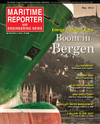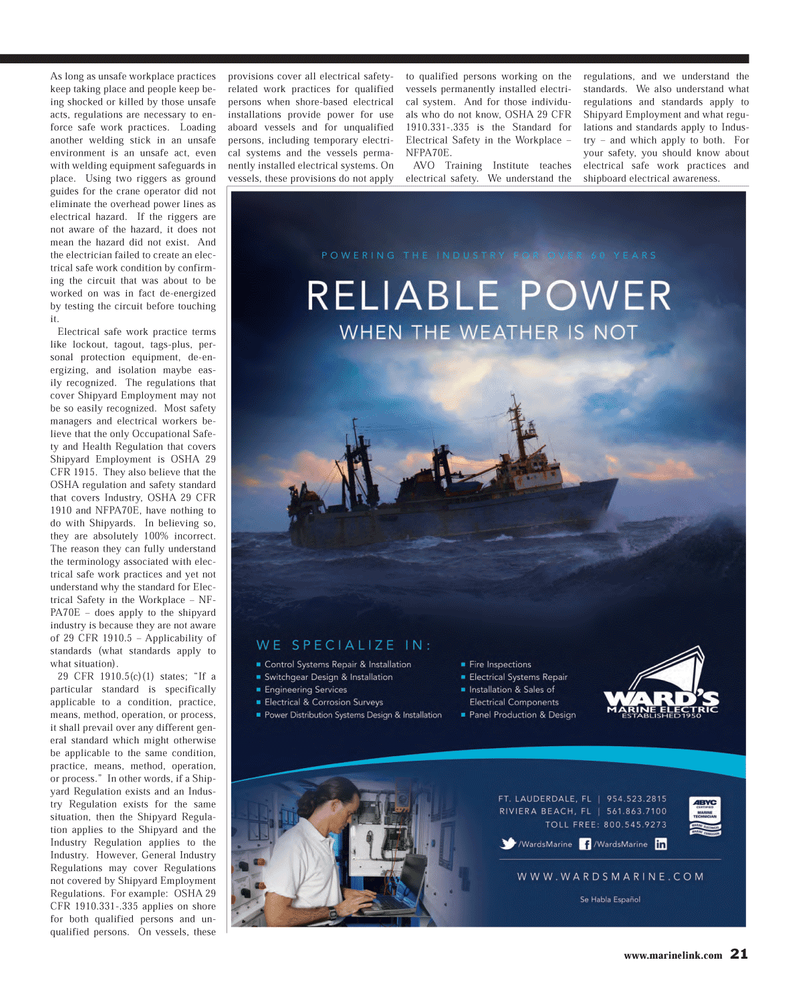
Page 21: of Maritime Reporter Magazine (May 2013)
Energy Production & Transportation
Read this page in Pdf, Flash or Html5 edition of May 2013 Maritime Reporter Magazine
www.marinelink.com 21As long as unsafe workplace practices keep taking place and people keep be-ing shocked or killed by those unsafe acts, regulations are necessary to en-force safe work practices. Loading another welding stick in an unsafe environment is an unsafe act, even with welding equipment safeguards in place. Using two riggers as ground guides for the crane operator did not eliminate the overhead power lines as electrical hazard. If the riggers are not aware of the hazard, it does not mean the hazard did not exist. And the electrician failed to create an elec-trical safe work condition by confirm-ing the circuit that was about to be worked on was in fact de-energized by testing the circuit before touching it.Electrical safe work practice terms like lockout, tagout, tags-plus, per- sonal protection equipment, de-en-ergizing, and isolation maybe eas- ily recognized. The regulations that cover Shipyard Employment may not be so easily recognized. Most safety managers and electrical workers be-lieve that the only Occupational Safe-ty and Health Regulation that covers Shipyard Employment is OSHA 29 CFR 1915. They also believe that the OSHA regulation and safety standard that covers Industry, OSHA 29 CFR 1910 and NFPA70E, have nothing to do with Shipyards. In believing so, they are absolutely 100% incorrect. The reason they can fully understand the terminology associated with elec-trical safe work practices and yet not understand why the standard for Elec-trical Safety in the Workplace ? NF- PA70E ? does apply to the shipyard industry is because they are not aware of 29 CFR 1910.5 ? Applicability of standards (what standards apply to what situation). 29 CFR 1910.5(c)(1) states; ?If a particular standard is specifically applicable to a condition, practice, means, method, operation, or process, it shall prevail over any different gen- eral standard which might otherwise be applicable to the same condition, practice, means, method, operation, or process.? In other words, if a Ship-yard Regulation exists and an Indus-try Regulation exists for the same situation, then the Shipyard Regula-tion applies to the Shipyard and the Industry Regulation applies to the Industry. However, General Industry Regulations may cover Regulations not covered by Shipyard Employment Regulations. For example: OSHA 29 CFR 1910.331-.335 applies on shore for both qualified persons and un-qualified persons. On vessels, these provisions cover all electrical safety-related work practices for qualified persons when shore-based electrical installations provide power for use aboard vessels and for unqualified persons, including temporary electri-cal systems and the vessels perma-nently installed electrical systems. On vessels, these provisions do not apply to qualified persons working on the vessels permanently installed electri-cal system. And for those individu- als who do not know, OSHA 29 CFR 1910.331-.335 is the Standard for Electrical Safety in the Workplace ? NFPA70E. AVO Training Institute teaches electrical safety. We understand the regulations, and we understand the standards. We also understand what regulations and standards apply to Shipyard Employment and what regu-lations and standards apply to Indus-try ? and which apply to both. For your safety, you should know about electrical safe work practices and shipboard electrical awareness.MR #5 (18-25).indd 21MR #5 (18-25).indd 214/30/2013 9:40:54 AM4/30/2013 9:40:54 AM

 20
20

 22
22
